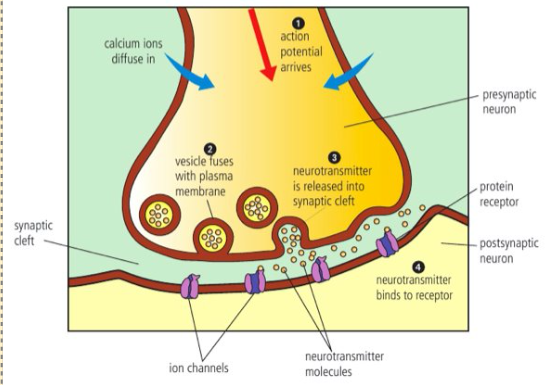Chemical signals in neurons
What is a neurotransmitter?
a neurotransmitter is a chemical signal that transfers information across a synapse.
there are more than 100 neurotransmitters.
agonists and antagonists affect the uptake of neurotransmitters.
action potentials
action potentials only move along a continuous membrane
an action potential is the depolarization of a lipid bilayer
the junction between neurons is a synapse
Synaptic transmissions:
action potential arrives at axon button of pre-synaptic neuron
This triggers the opening of Ca2+ channels in the plasma membrane, this allows Ca2+ to diffuse in.
Small molecules called neurotransmitters are store in vesicles close tot he pre-synaptic plasma membrane. The Ca2+ triggers the vesicles to fuse with the plasma membrane releasing neurotransmitters into the synaptic cleft
the neurotransmitter diffuses across the synaptic cleft
Neurotransmitter binds to receptors in the post-synaptic membrane. the receptor is a ligand gated ion channel. this allows for the opening of receptor ion channels which depolarizes the post synaptic membrane causing an action potential.
Example question: Why is synaptic transmission a unidirectional Process?
There is an asymmetric distribution of key molecules in the synapse. The vesicles are only on the pre-synaptic neuron. the pre-synaptic neuron does not have ligand gated channels but the post-synaptic neuron does. so the pre-synaptic neuron can only release the neurotransmitter and the post-synaptic neuron can only receive them making it unidirectional.
 Example:
Example:
Acetylcholine:
Acetylcholine is released both at synapses and at contacts between motor neurons and muscle cells.
it is broken down by an enzyme (acetylcholinesterase) in the synaptic cleft so transmission is brief - only one action potential is sent.
Botox is an inhibitor of acetylcholine - it keeps the acetylcholine from binding to the post-synaptic neuron. this paralyses the muscles.